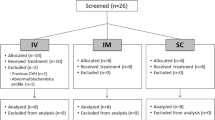Abstract
We evaluated the postoperative pain relief and side-effects of continuous epidural infusion of three analgesic regimens following major thoracic and/or abdominal surgery. One hundred and twenty patients were randomly divided into three treatment groups: (1) 0.25% or 0.5% bupivacaine at a rate of 3–7 ml·hr−1, (2) 0.01% morphine at a rate of 1–2 ml·hr−1, (3) a combination of 0.125% or 0.25% bupivacaine and 0.0025% or 0.005% morphine at a rate of 2–4 ml·hr−1. The study continued for the first 48 postoperative hours. The effect of pain relief was evaluated by assessment of the further requirement for parenteral analgesics. Sixty-four percent of the patients given bupivacaine, 56% of the patients given morphine and 80% of the patients given the combination required no supplemental analgesics. Continuous epidural infusion of bupivacaine was associated with hypotension (21%) and with numbness and weakness of hands or legs (18%). Continuous epidural infusion of morphine was associated with pruritus (18%) and with peristaltic depression (12%). The combination regimen was associated with pruritus (17%) and with drowsiness (14%). We conclude that the combination of bupivacaine and morphine significantly provides superior analgesia with less deleterious complications compared with either bupivacaine or morphine alone.
Similar content being viewed by others
References
Ross RA, Clarke JE, Armitage EN: Postoperative pain prevention by continuous epidural infusion. Anaesthesia 35:663–668, 1980
Pflug AE, Murphy TM, Butler SH, Tucker GT: The effects of postoperative peridural analgesia on pulmonary therapy and pulmonary complications. Anesthesiology 41:817, 1974
El-Baz NM, Faber LP, Jensik RJ: Continuous epidural infusion of morphine for treatment of pain after thoracic surgery: a new technique. Anesth Analg 63:757–764, 1984
Chrubasik J, Wiemers K: Continuous-pluson-demand epidural infusion of morphine for postoperative pain relief by means of a small, externally worn infusion device. Anesthesiology 62:263–267, 1985
Takasaki M, Hatano M, Saitoh Y, Nishio Y, Kawasaki H, Kosaka Y: Continuous epidural infusion of bupivacaine for postoperative pain relief. Masui (Jap J Anesth) 35:1550–1555, 1986
Saitoh, Y, Takasaki M, Kosaka Y: Continuous epidural infusion of 0.01% morphine for postoperative pain relief. Masui (Jap J Anesth) 37:47–52, 1988
Wahba WM, Don HF, Craig DB: Postoperative epidural analgesia: effects on lung volumes. Can Anaesth Soc J 22:519–527, 1975
Mankikian B, Cantineau JP, Bertrand M, Kieffer E, Sartene R, Viars P: Improvement of diaphragmatic function by a thoracic extradural block after upper abdominal surgery. Anesthesiology 68:379–386, 1988
Kehlet H: The modifying effect of general and regional anesthesia on the endocrinemetabolic response to surgery. Reg Anesth 7:S38–48, 1982
Bromage PR: Physiology and pharmacology of epidural analgesia. Anesthesiology 28:592–622, 1967
Renck H, Edstrom H, Kinnberger B, Brandt G: Thoracic epidural analgesia- II: prolongation in the early postoperative period by continuous injection of 1.0% bupivacaine. Acta Anaesthesiol Scand 20:47–56, 1976
Thoren T, Wattwil M: Effects on gastric emptying of thoracic epidural analgesia with morphine of bupivacaine. Anesth Analg 67:687–694, 1988
Rawal N, Wattwil M: Respiratory depression after epidural morphine — an experimental and clinical study. Anesth Analg 63:8–14, 1984
Simmoneau G, Vivien A, Sartene R, Kunstlinger F, Samii K, Noviant Y, Duroux P: Diaphragm dysfunction induced by upper abdominal surgery: role of postoperative pain. Am Rev Respir Dis 128:899–903, 1983
Hjortso NC, Lund C, Mogensen T, Bigler D, Kehlet H: Epidural morphine improves pain relief and maintains sensory analgesia during continuous epidural bupivacaine after abdominal surgery. Anesth Analg 65:1033–1036, 1986
Fischer RL, Lubenow TR, Liceaga A, McCarthy RJ, Ivankovich AD: Comparison of continuous epidural infusion of fentanyl-bupivacaine and morphine-bupivacaine in management of postoperative pain. Anesth Analg 67:559–563, 1988
Cullen ML, Staren ED, El-Ganzouri A, Logas WG, Ivankovich AD, Economou SG: Continuous epidural infusion for analgesia after major abdominal operations: a randomized, prospective, double-blind study. Surgery 98:718–728, 1985
Logas WG, El-Baz NM, El-Ganzouri A, Cullen M, Staren E, Faber LP, Ivankovich AD: Continuous thoracic epidural analgesia for postoperative pain relief following thoracotomy: a randomized prospective study. Anesthesiology 67:787–791, 1987
Gelman S, Feigenberg Z, Dintzman M, Levy E: Electroenterography after cholecystectomy: the role of high epidural analgesia. Arch Surg 112:580–583, 1977
Author information
Authors and Affiliations
About this article
Cite this article
Sakura, S., Uchida, H., Saito, Y. et al. Continuous epidural infusion for postoperative pain relief: A comparison of three regimens. J Anesth 4, 138–144 (1990). https://doi.org/10.1007/s0054000040138
Received:
Accepted:
Issue Date:
DOI: https://doi.org/10.1007/s0054000040138




